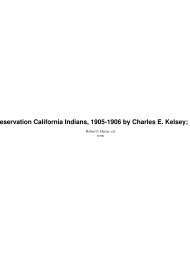Spring 2008 - Yosemite Conservancy
Spring 2008 - Yosemite Conservancy
Spring 2008 - Yosemite Conservancy
- No tags were found...
You also want an ePaper? Increase the reach of your titles
YUMPU automatically turns print PDFs into web optimized ePapers that Google loves.
and Scenic River continues through an incised river canyon<br />
to its impoundment at Lake Maclure, where its status<br />
as a wild and scenic river ends. Beyond, it too joins the<br />
San Joaquin River in Merced County.<br />
The Tuolumne River is wild and free flowing, even as it enters<br />
Hetch Hetchy Reservoir. Its wild and scenic river designation is<br />
interrupted here, but resumes directly below O’Shaughnessy Dam.<br />
are fortunate enough to visit.<br />
Beyond <strong>Yosemite</strong>’s borders, the Tuolumne River flows<br />
through lands managed by both the U.S. Forest Service<br />
and the Bureau of Land Management, its wild and scenic<br />
status coming to an end at Lake Don Pedro. But the river<br />
continues itself for miles, eventually reaching its confluence<br />
with the San Joaquin River just outside of Modesto.<br />
THE MERCED<br />
Like the Tuolumne, the Merced also originates from<br />
Mount Lyell, but off of its southern shoulder. The Lyell<br />
Fork of the Merced River is joined by three other primary<br />
forks—Triple Peak Fork, Red Peak Fork and Merced<br />
Peak Fork. These portions flow through a wild and<br />
largely trail-free landscape, eventually passing through<br />
Washburn Lake, Merced Lake and Little <strong>Yosemite</strong> Valley.<br />
Some of the Merced’s most iconic views can be seen as<br />
the river plunges over Nevada Fall and then Vernal Fall<br />
before its riotous springtime cascade into Happy Isles at<br />
the eastern end of <strong>Yosemite</strong> Valley.<br />
The main stem of the Merced River takes center<br />
stage in <strong>Yosemite</strong> Valley as it welcomes the waters of its<br />
more iconic tributaries—Tenaya Creek and Mirror Lake,<br />
<strong>Yosemite</strong> Falls, Sentinel Falls, Bridalveil Fall, Ribbon<br />
Fall and the Cascades. Ultimately, the Merced plunges<br />
through a gorge, descending some 2,000 feet over seven<br />
miles before leaving the park at the boundary of El Portal.<br />
At the southern end of the park, the South Fork of the<br />
Merced River emerges from southern wilderness and into<br />
the sleepy hollow of Wawona. This portion of the river<br />
joins the main stem on U.S. Forest Service land along<br />
Highway 140 at Savage’s Trading Post. The Merced Wild<br />
KRISTINA RYLANDS (2)<br />
WHAT IS A WILD AND SCENIC RIVER<br />
In the early 1960s, it was recognized that the nation’s<br />
rivers were being dammed, dredged, and degraded at<br />
an alarming rate. In response, Senator Frank Church<br />
of Idaho championed the Wild and Scenic Rivers Act<br />
until it was signed into law in 1968 by President Lyndon<br />
Johnson. This landmark piece of legislation acknowledges<br />
that free-flowing rivers and their unique natural, cultural<br />
and recreational values are a central part of our nation’s<br />
heritage and should be preserved for future generations.<br />
Today, 165 rivers have been designated, protecting over<br />
11,000 miles of river from Alaska to Puerto Rico, and<br />
Maine to Oregon.<br />
Prior to congressional designation, a river must be<br />
determined eligible and then suitable for wild and scenic<br />
river status. The process starts with an eligibility study to<br />
determine if the river can meet two key qualifications:<br />
1) Is the river largely free-flowing and 2) Does it possess<br />
what the Act terms “outstandingly remarkable values”<br />
These are the unique, rare or exemplary qualities that<br />
make the river stand apart from all others in the region or<br />
nation. (To be eligible for wild and scenic status, a river<br />
only needs to possess one such outstandingly remarkable<br />
value and be largely free-flowing.) Next, the river goes<br />
through a suitability study to determine if the Wild and<br />
Scenic Rivers Act is the most suitable way to protect the<br />
river. Once these two studies are completed, Congress can<br />
act to designate a river by adding it to the wild and scenic<br />
river system.<br />
Far from putting rivers behind velvet ropes, the Wild<br />
and Scenic Rivers Act is meant to allow people to continue<br />
The Tuolumne River meanders through a glacially carved,<br />
snowcapped landscape. The Tuolumne was instrumental in<br />
creating this unique and magnificent scenery.<br />
4 YOSEMITE ASSOCIATION, SPRING <strong>2008</strong>


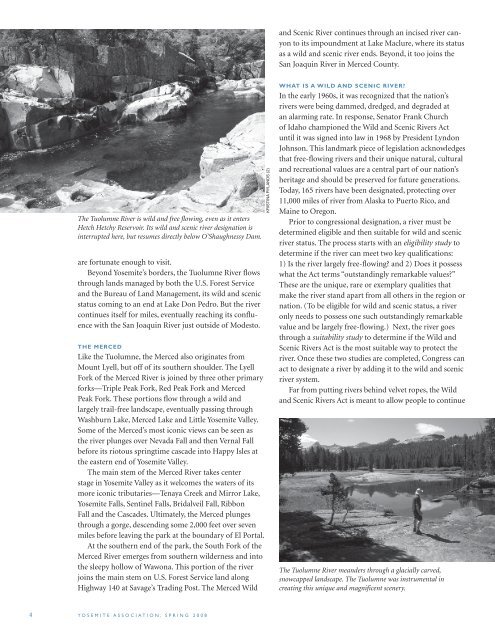

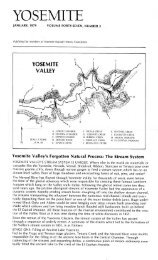
![(March 1982) [PDF] “We Are Pleased to Announce†- Yosemite Online](https://img.yumpu.com/51299748/1/190x242/march-1982-pdf-aeuroewe-are-pleased-to-announceaeur-yosemite-online.jpg?quality=85)
![[PDF] Old Horny, Yosemite's Unicorn Buck - Yosemite Online](https://img.yumpu.com/51269869/1/184x260/pdf-old-horny-yosemites-unicorn-buck-yosemite-online.jpg?quality=85)
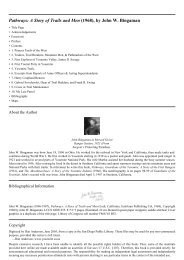
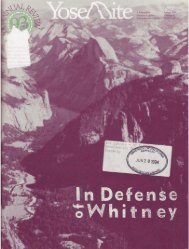
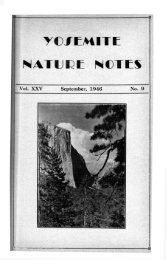
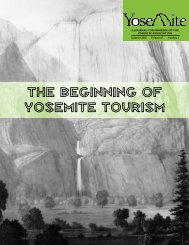
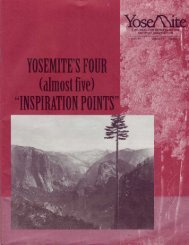
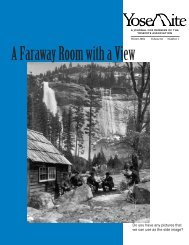
![1985 [PDF] - Yosemite](https://img.yumpu.com/48128837/1/184x260/1985-pdf-yosemite.jpg?quality=85)

